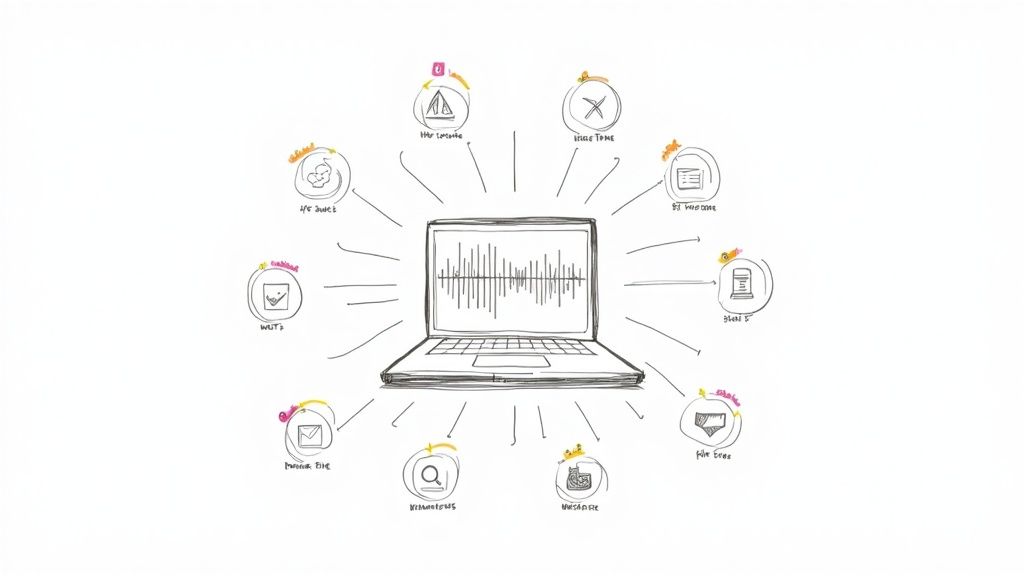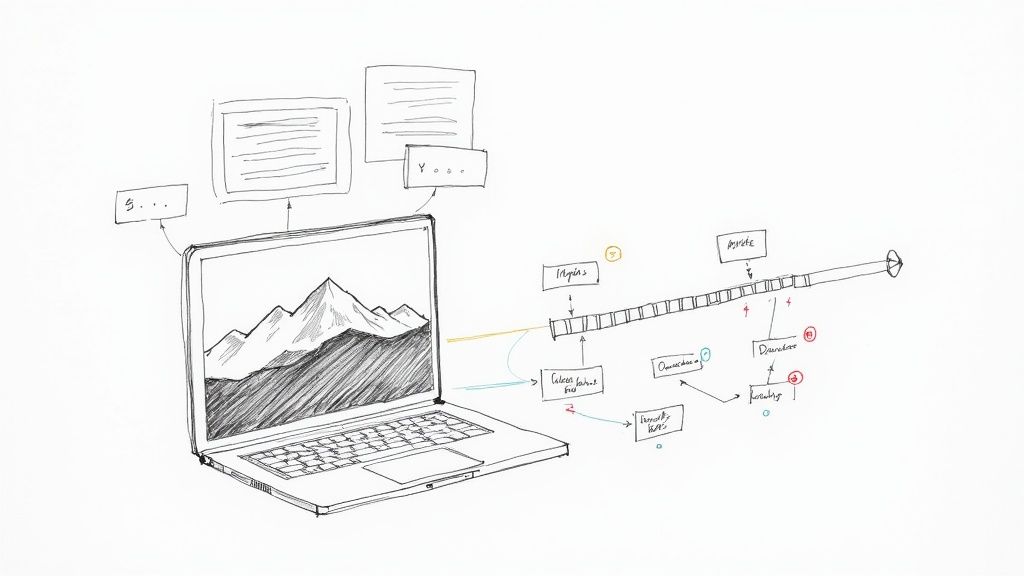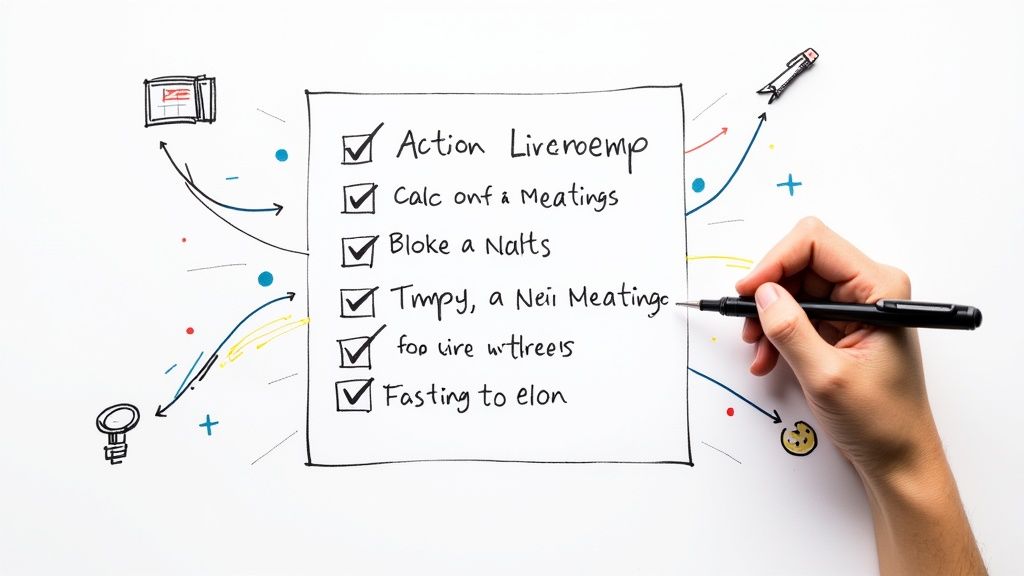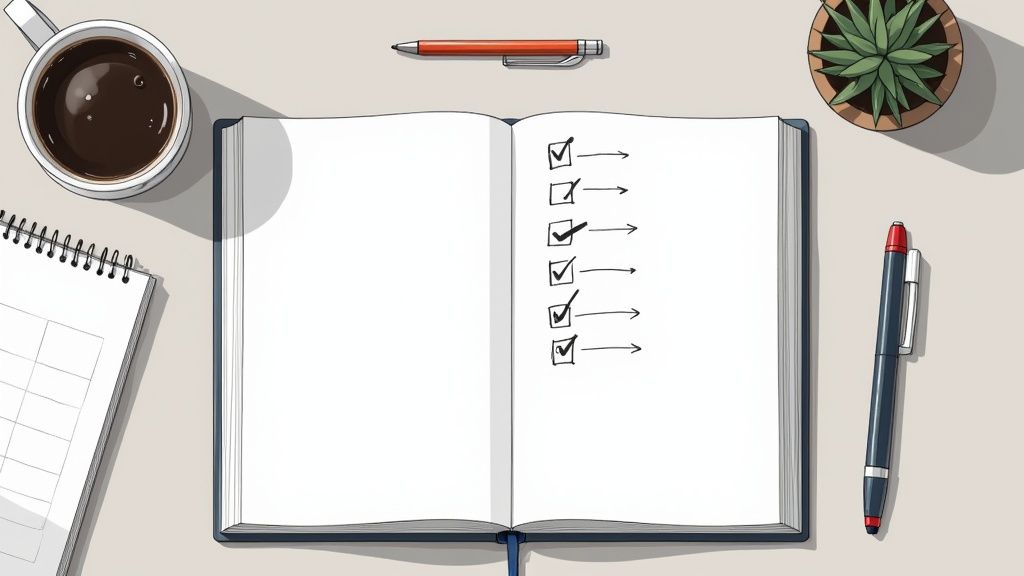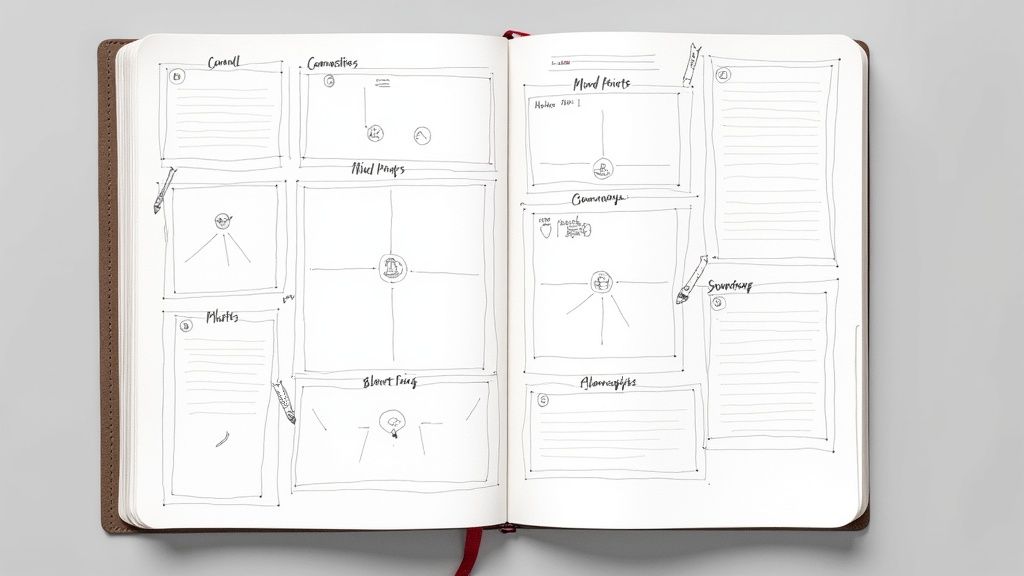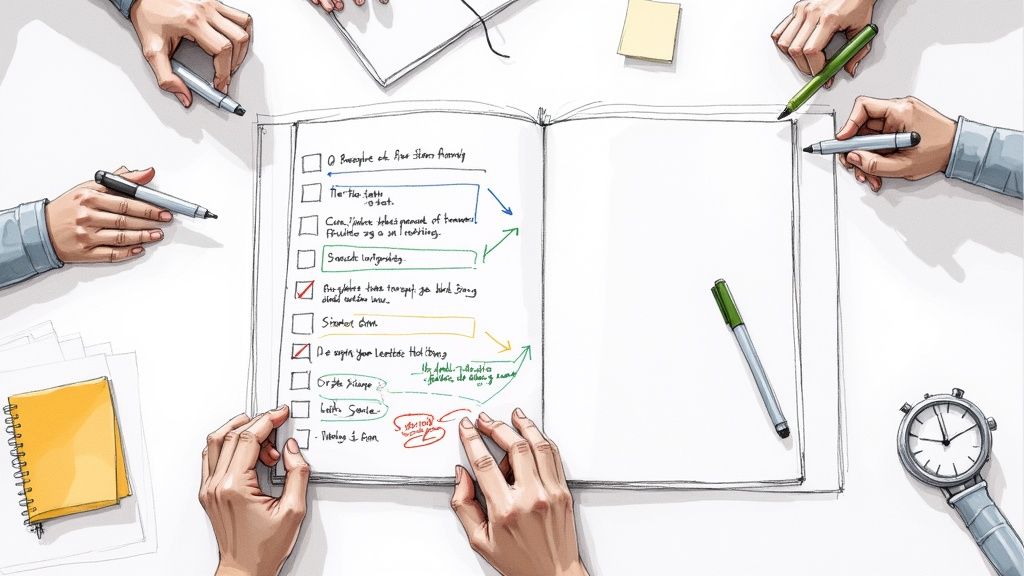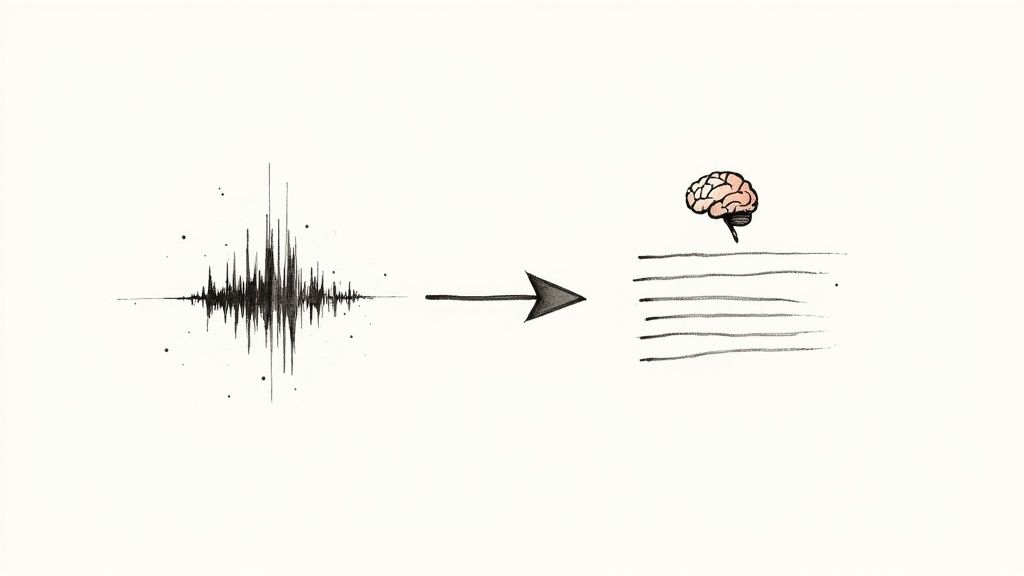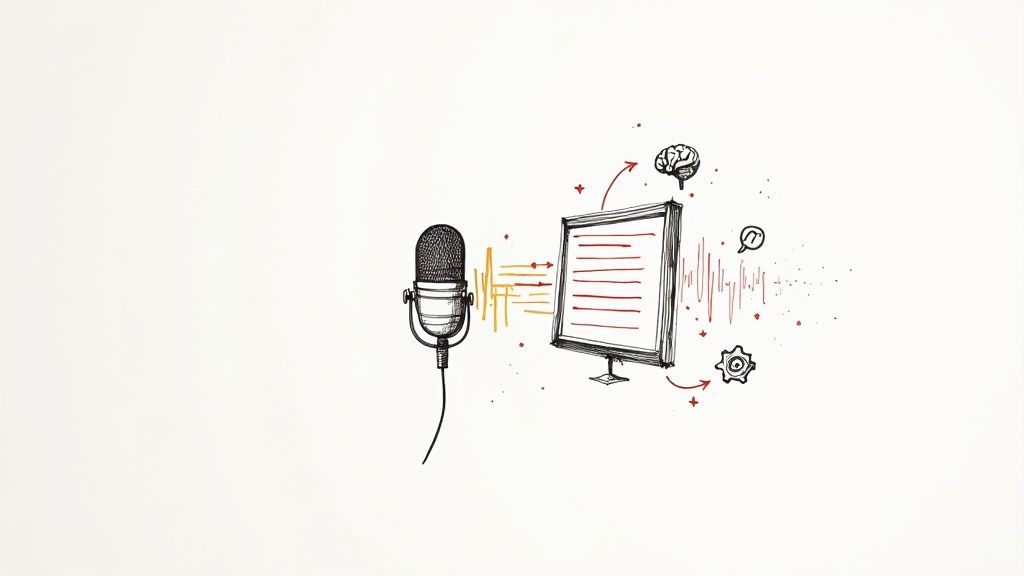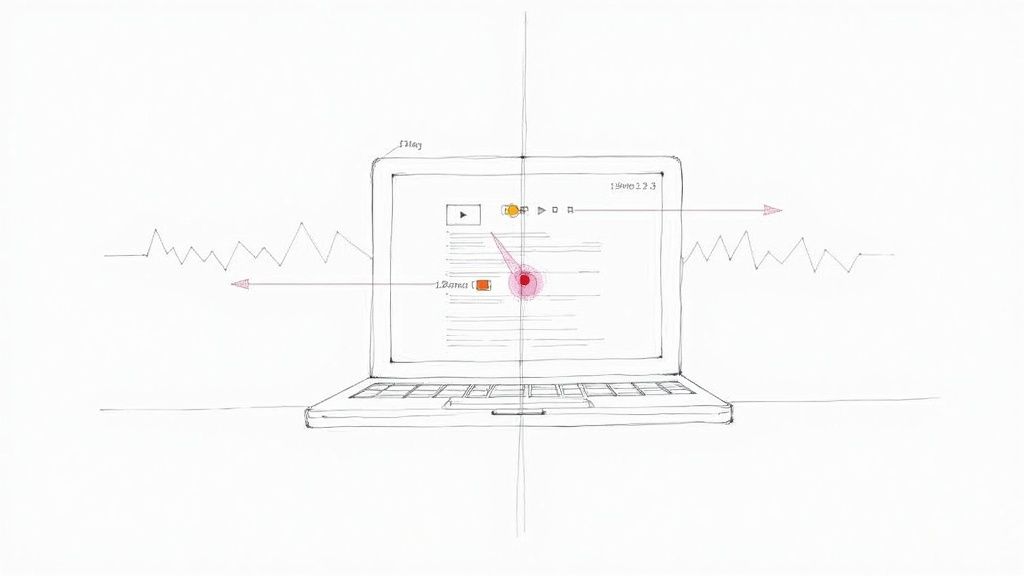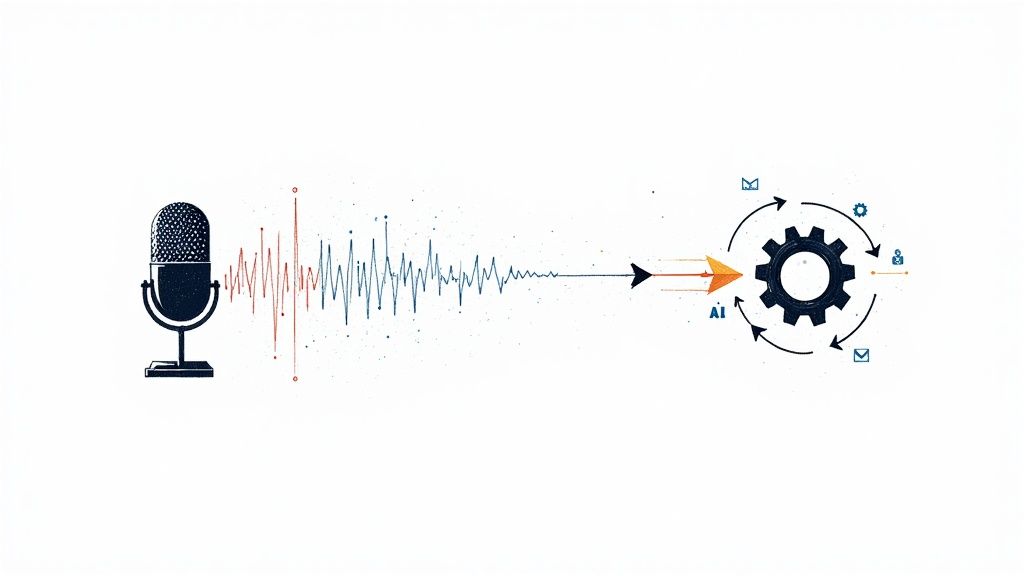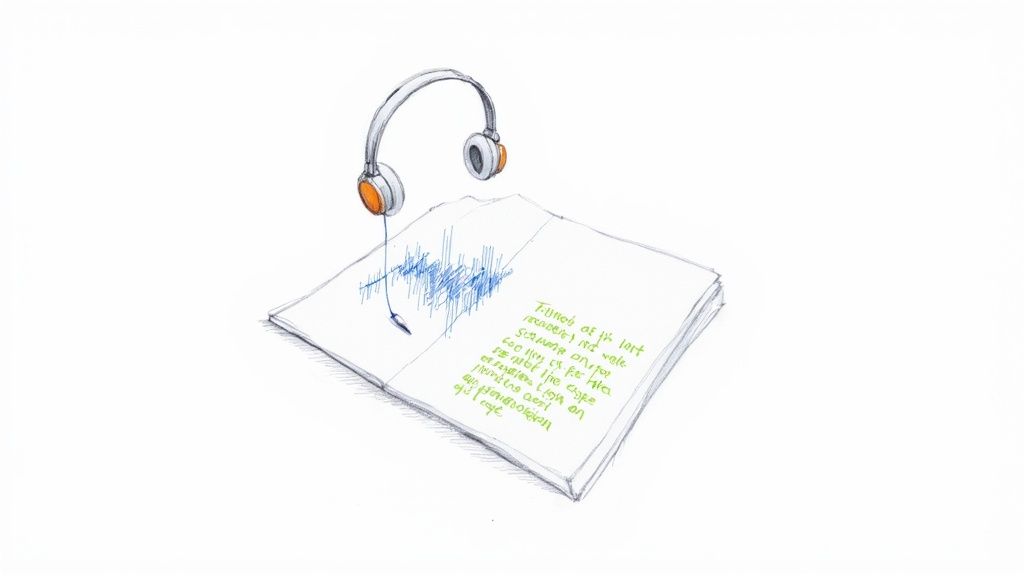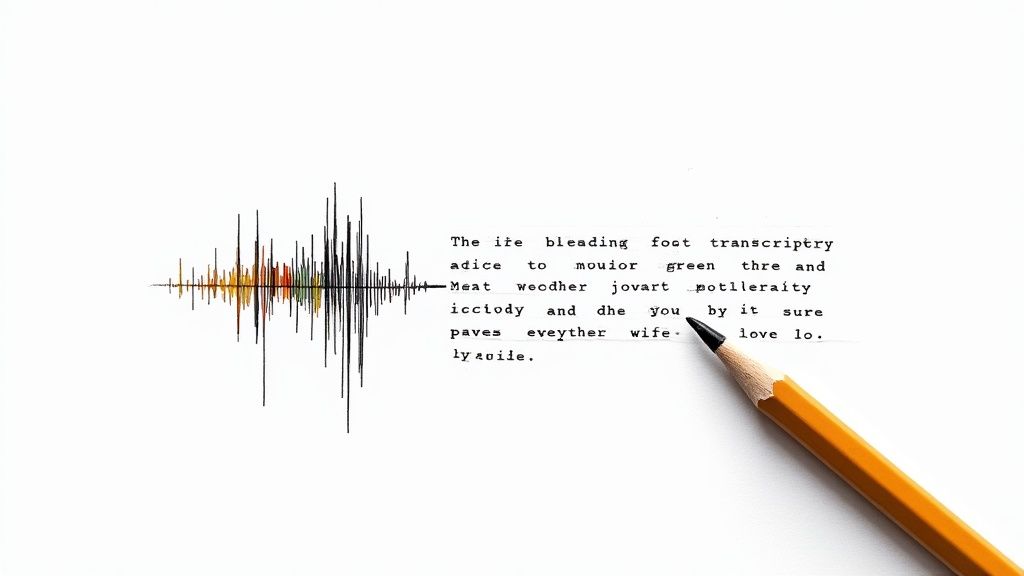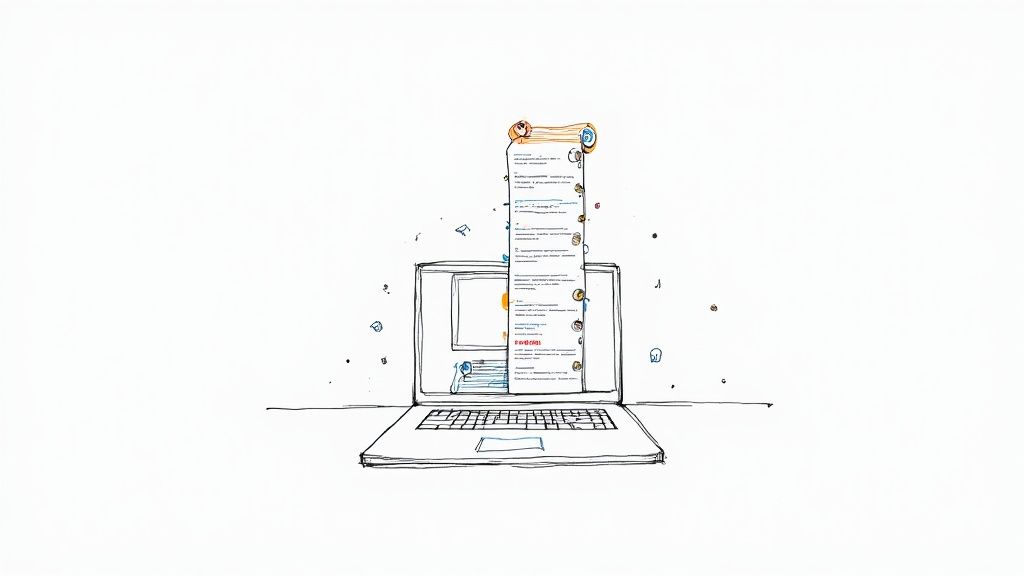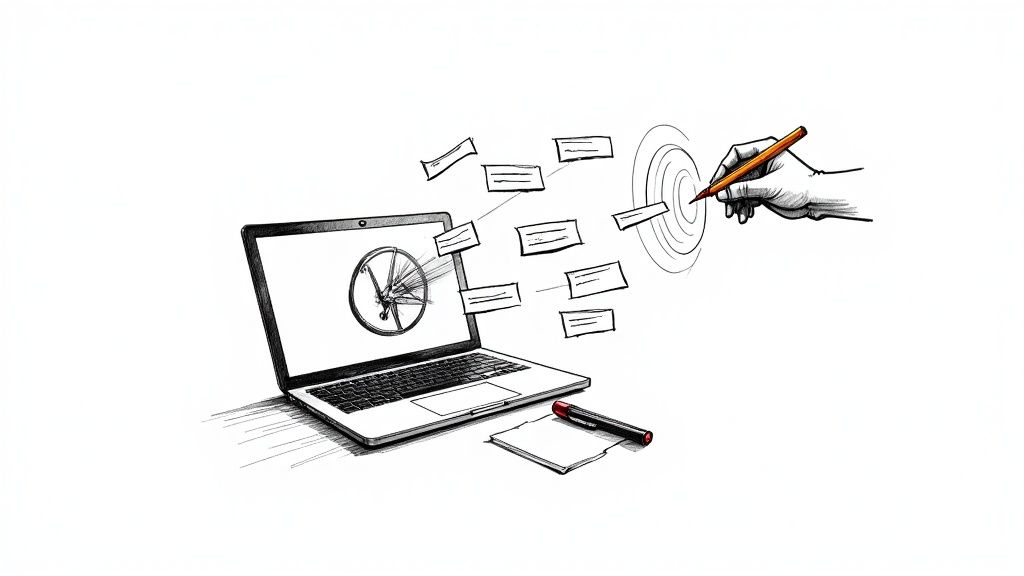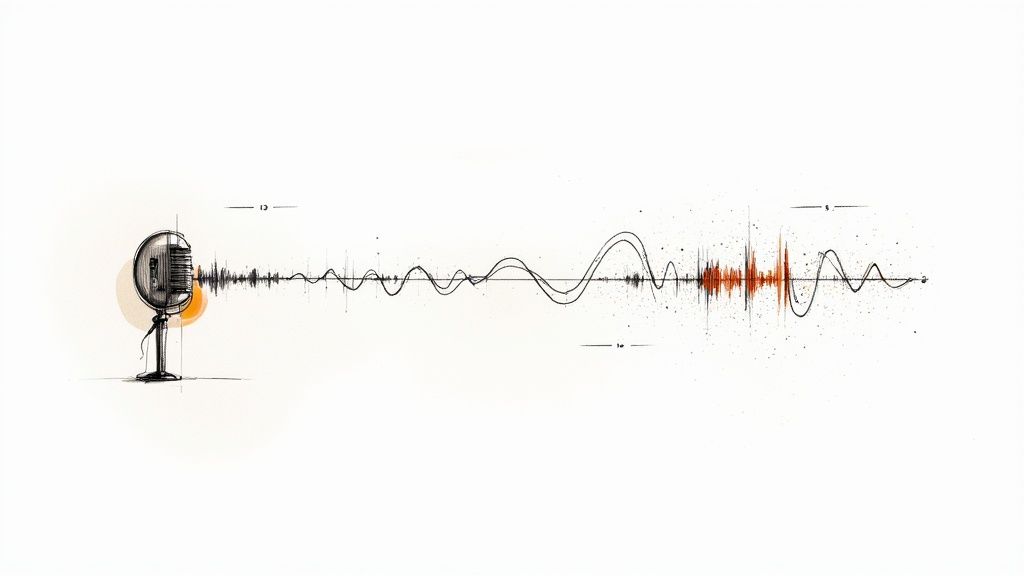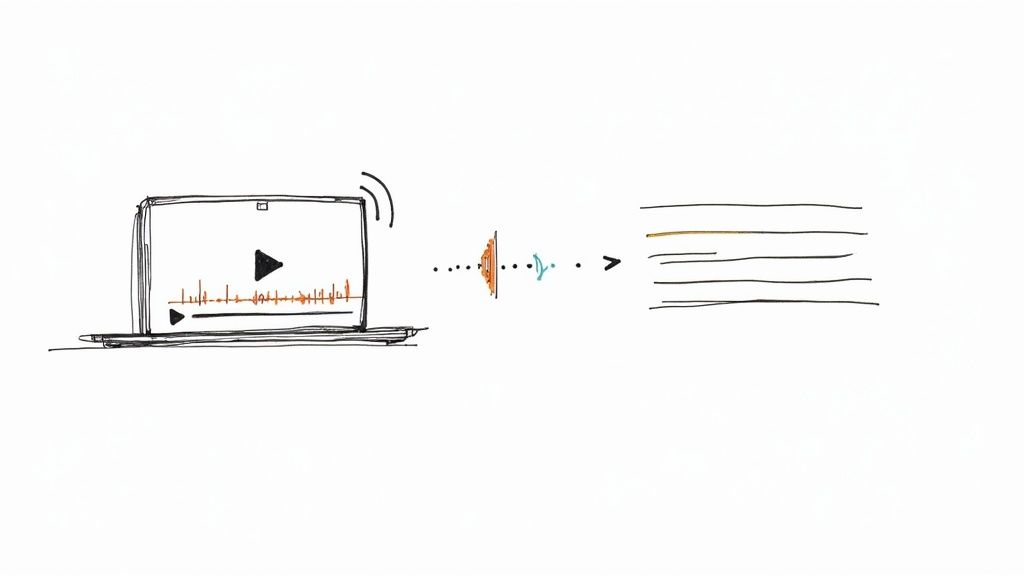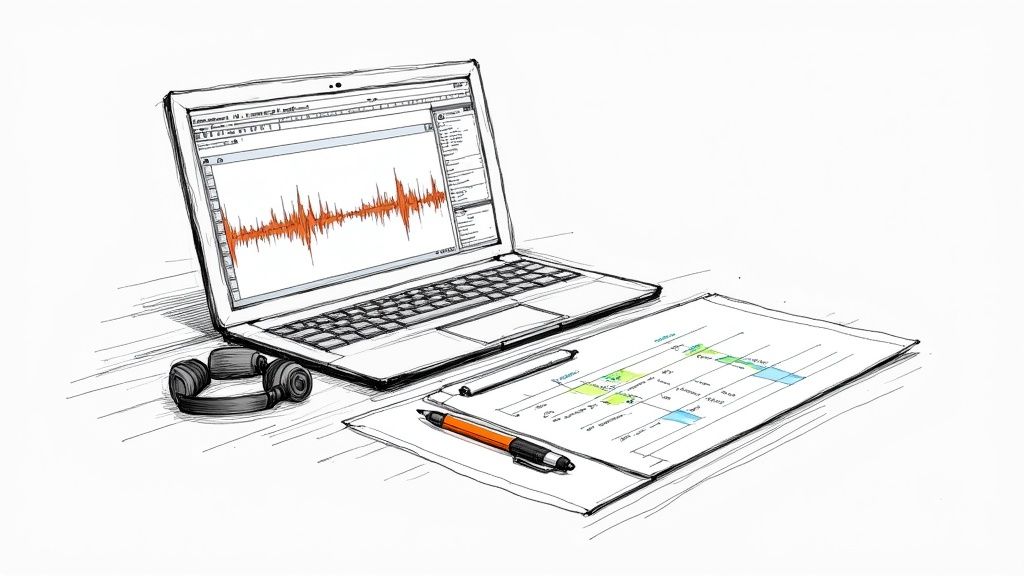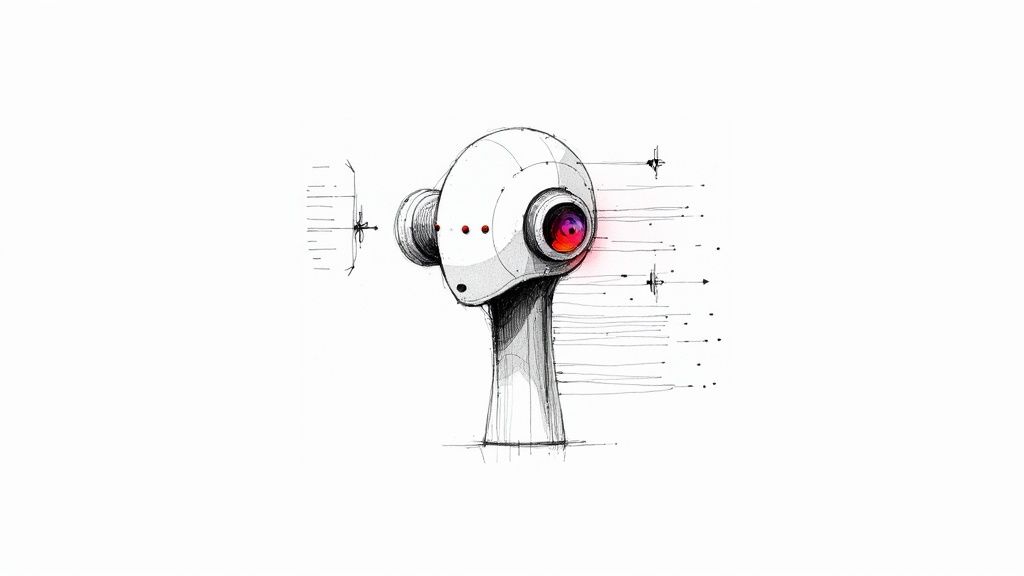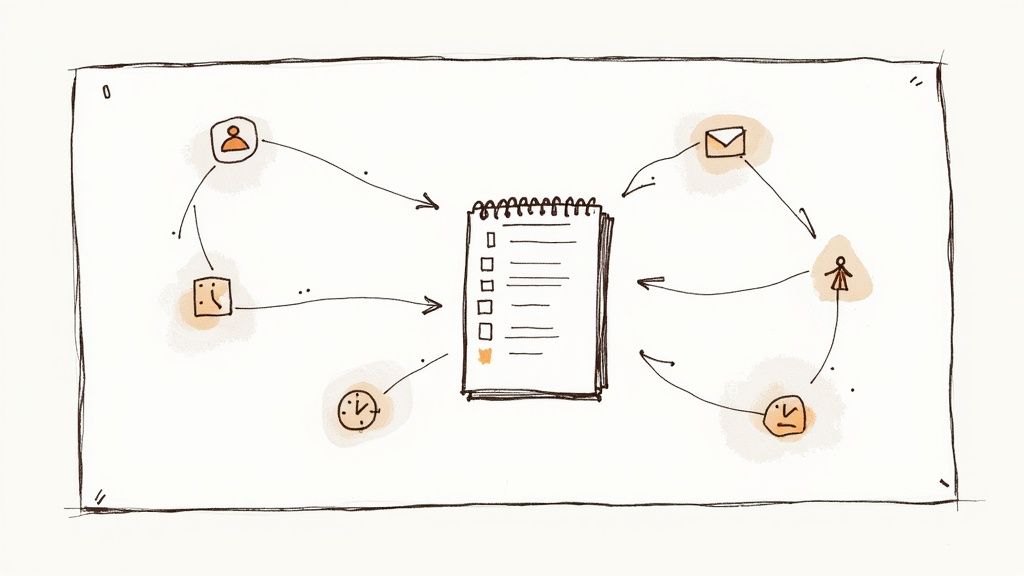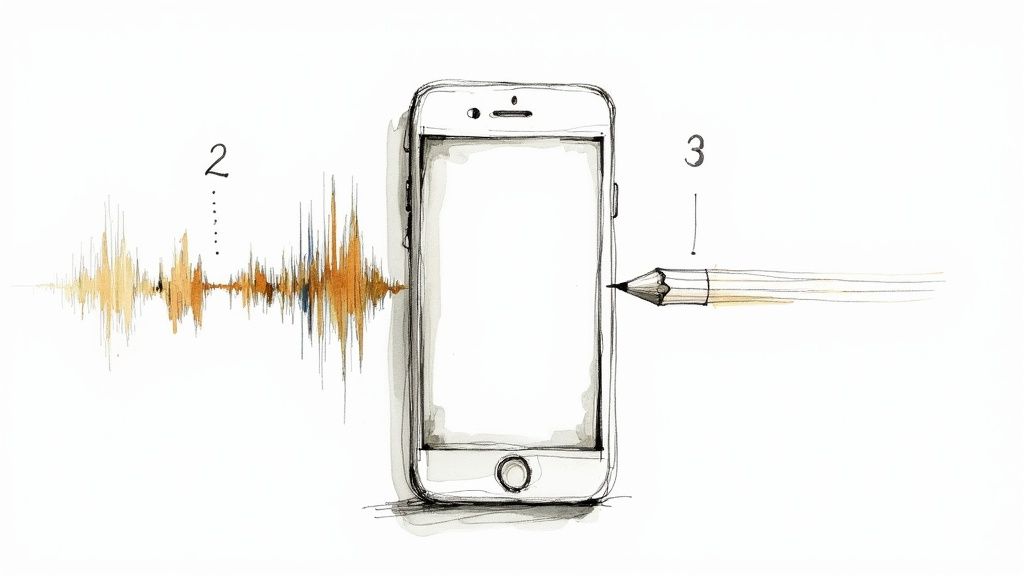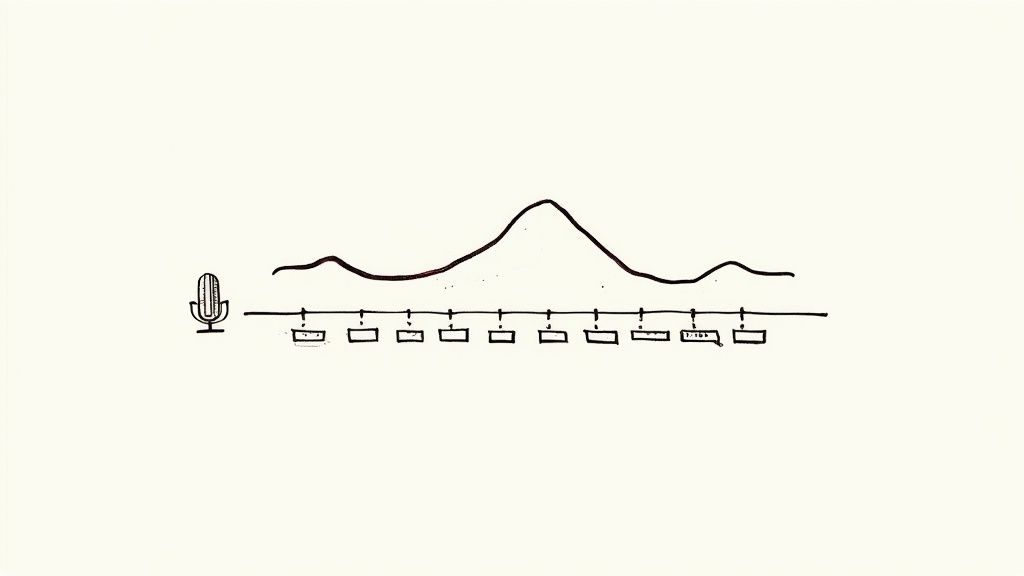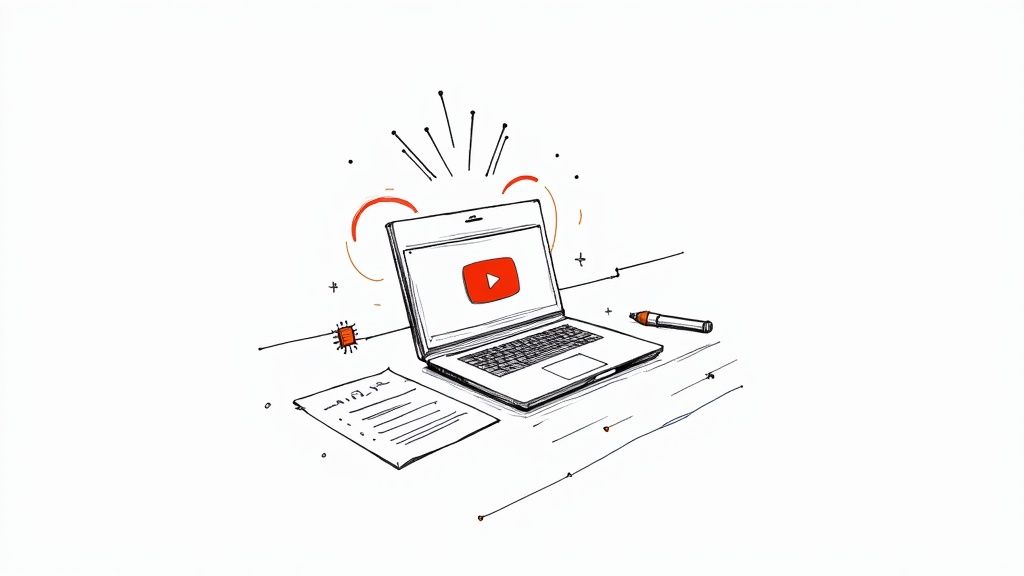
Taking Minutes in a Meeting Made Simple: A Practical Guide
Taking meeting minutes is far more than just scribbling down notes; it’s about creating the official, go-to record of what was discussed, what was decided, and who's responsible for what comes next. When you learn how to do this effectively, you transform a simple conversation into real, measurable progress. This guide shares my experience-based process for turning this often-dreaded task into a strategic skill.
Why Great Meeting Minutes Are a Business Superpower

Let’s be honest—taking minutes can feel like a thankless chore. It's often viewed as a simple administrative task, but that perspective completely misses the point. Think about a high-stakes project meeting where incredible ideas are flying and major decisions are being hammered out, only for everyone's memory to get hazy a week later. That’s where a skilled minute-taker saves the day.
Well-crafted minutes become the single source of truth that prevents this kind of chaos. They're one of the most essential project management forms you can have, bringing clarity to complex discussions and making sure everyone is on the same page. No more "I thought we agreed to..." debates when you have a clear, documented record of what actually happened.
The average professional spends nearly 15 hours a week in meetings. With ineffective meetings costing the U.S. economy an estimated $37 billion each year and 65% of workers saying meetings keep them from their actual work, solid documentation is the key to making that time count.
The Foundation of Accountability
Without a formal record, accountability is based on memory, and we all know how unreliable that can be. This is where expertly prepared minutes make a huge difference. They solve the problem by clearly spelling out the essentials.
Before we dive into the how, let's quickly break down what every set of meeting minutes should contain. Think of this as your cheat sheet for capturing what truly matters.
What Should Be Included in Meeting Minutes?
By documenting these elements, you’re not just taking notes—you're building a framework for follow-up and progress tracking.
Turning Talk into Tangible Action
The real magic of meeting minutes is their power to translate conversation into concrete action. They create a clear roadmap for what needs to happen after everyone leaves the room. It’s not about capturing every word spoken, but about capturing what was decided.
This guide is designed to give you a complete, modern workflow for taking minutes. We'll cover everything from smart preparation before the meeting even starts to using AI tools to make the whole process faster and more accurate. My goal is to help you create records that your team will actually find useful.
How to Prepare for Taking Minutes in a Meeting
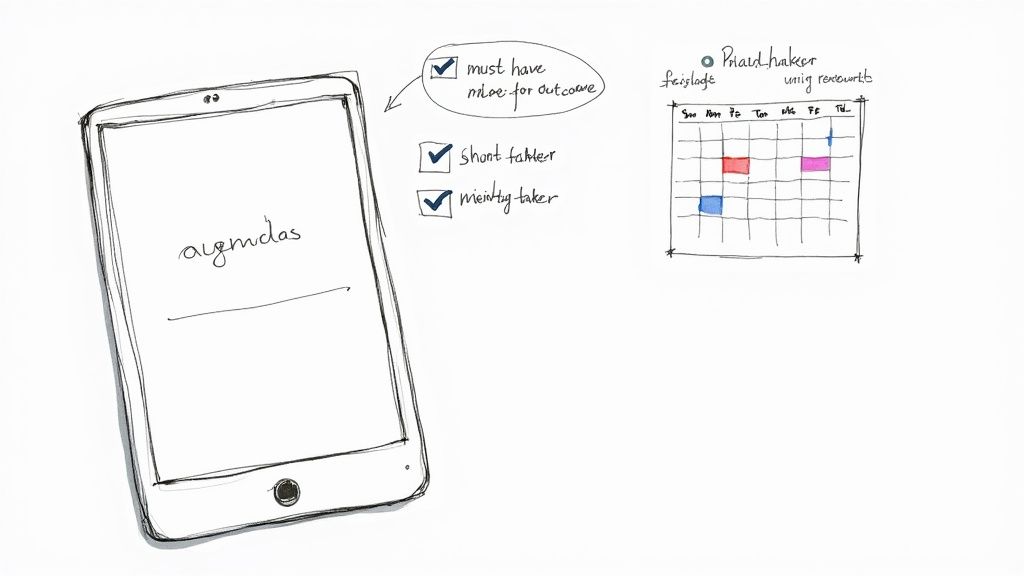
The secret to taking great meeting minutes doesn't start when the meeting does. It’s all about what you do beforehand. Walking into a meeting unprepared is like trying to navigate a new city without a map—you'll get lost in the conversation and completely miss the important landmarks. My pre-game strategy turns what could be a stressful task into a controlled, smooth process.
This whole process is about setting up a system that frees you up to listen to the conversation, not just frantically type to keep up. It all starts with one simple, powerful step: connecting with the person leading the meeting.
Before any significant meeting, I always schedule a quick five-minute chat with the chair or facilitator. This isn't just a courtesy; it's a strategic move to get on the same page about the meeting's real purpose.
Pinpoint the Must-Have Outcomes
During this brief conversation, my only goal is to understand the core objective. I ask direct questions to cut through the noise and figure out what actually needs to be on the record. That clarity is absolutely essential for taking minutes in a meeting effectively.
Here are the questions I find most effective:
- "What is the single most important decision we need to make today?"
- "What key action items are you hoping will come out of this discussion?"
- "Are there any sensitive topics I should be aware of or handle with extra care in the notes?"
- "Is there a specific outcome you need documented for compliance or project tracking?"
Asking these questions completely changes your role. You're no longer just a scribe; you become a strategic partner, ensuring the meeting’s goals are captured and turned into a useful, actionable record.
My number one rule for preparation is to never assume the agenda tells the whole story. A quick chat with the meeting lead always reveals the hidden priorities and desired outcomes that absolutely have to be documented.
This pre-meeting alignment is even more critical when you realize just how many meetings lack a clear structure. A troubling statistic reveals that 64% of recurring meetings and 60% of one-off meetings don’t even have a structured agenda. You can read more about these impactful meeting statistics and their implications. Building a template based on a clear agenda is one of the best ways to fight back against this chaos.
Build Your Template from the Agenda
Once you have the agenda, use it as the skeleton for your minutes. Don't wait until the meeting is underway to create your document—a little prep work here saves a massive amount of stress later.
My process is simple but it works every time. I create a new document and structure it with the basic info and agenda items as headings.
My Pre-Meeting Template Checklist:
- The Basics: I start by filling in the easy stuff: meeting title, date, time, and location (or video conference link).
- Attendee List: I pre-populate the list of invitees. This makes it simple to just check off who is present and who is absent once the meeting begins.
- Agenda as Headings: I copy each agenda item into the document, turning them into bolded headings. This creates a logical flow and organized containers for my notes.
- Action Item Section: I always create a dedicated section at the bottom called "Action Items Summary" with columns for the task, the owner, and the deadline. This gives me a designated spot to consolidate these crucial takeaways as they come up.
This structure acts as your roadmap. During the meeting, you’re not starting from a blank page; you’re simply filling in the details under the appropriate headings. It keeps you organized and ensures no key topics get missed.
Finally, do a quick tech check. Is your laptop charged? Is your software (like Word, Google Docs, or a dedicated app) open and ready? Are any recording tools good to go? With your template built and your tools ready, you’re prepared to capture what matters, not just what’s said.
How to Record Minutes During a Meeting
Once the meeting starts, your role flips from planner to strategic listener. Many people mistakenly think their job is to be a court stenographer, capturing every single word. That’s a fast track to burnout and a useless document. Your real job is to filter the signal from the noise and pinpoint the moments that actually matter.
Discussions will naturally wander. There will be tangents and brainstorming. Your mission is to stay anchored to the agenda and listen intently for the specific phrases that signal a decision has been made or a commitment has been locked in.
Listening for Key Phrases
With a little practice, you'll develop a keen ear for the language of decision-making. Certain phrases are like bright neon signs, telling you something important just happened that absolutely must be written down.
Train yourself to perk up when you hear things like:
- "So, the decision is..."
- "Let's confirm that we're moving forward with..."
- "Okay, so the action item here is..."
- "Who's going to take the lead on that?"
- "We need this done by..."
When you hear one of these, that's your cue. Stop summarizing the general discussion and start recording a concrete outcome. This kind of active listening is infinitely more valuable than a word-for-word transcript.
My personal rule is this: If I can't tie a piece of information back to a specific decision, action item, or key discussion point on the agenda, it probably doesn't belong in the final minutes. This keeps the record clean, concise, and focused on results.
This approach transforms the final document from a simple record into a tool for action. By focusing on these trigger phrases, you guarantee the meeting's most critical outputs—the decisions made and tasks assigned—are captured with absolute clarity. This focused technique is a cornerstone of how to take effective meeting notes that people will actually read.
Choosing Your Note-Taking Method
There's no single "best" way to take notes; what works for one person might not work for another. It really comes down to your personal style and the type of meeting you're in. The goal is to land on a system that lets you be both fast and accurate.
Let's break down a few popular methods.
Structured Digital Templates
This is the go-to for a reason. Using the template you prepped beforehand in a tool like Google Docs or Microsoft Word gives you a solid framework to work from. As the conversation flows, you just fill in the details under each agenda item.
- Pros: It’s highly organized, super easy to share and edit later, and looks professional right from the start.
- Cons: It can feel a bit rigid, especially if the discussion jumps around a lot.
Mind Mapping
For more creative, free-flowing brainstorming sessions, a mind map can be an incredibly powerful tool. You start with the main topic in the center and create branches for agenda items, new ideas, decisions, and action items as they come up.
- Pros: Fantastic for visualizing how ideas connect and for capturing discussions that don't follow a straight line.
- Cons: The result can look messy and often requires extra work to translate into a formal, linear document afterward.
Developing a Personal Shorthand
No matter which method you pick, speed is the name of the game. You can’t possibly keep up if you’re trying to type out full sentences. Creating your own system of symbols and abbreviations will dramatically boost your efficiency.
Here are a few I use all the time to give you some ideas:
You don't need to learn an official shorthand system. Just come up with a personal code that makes sense to you. It's all about keeping pace with the conversation without missing the important stuff.
How to Seek Clarification Politely
So, what do you do when a decision is mentioned, but the details are fuzzy? Or when an action item is assigned with no clear owner or deadline? Part of your job is to ensure the minutes are rock-solid, and sometimes that means you have to speak up.
The key is to do it without derailing the meeting’s momentum. Wait for a natural pause in the conversation—the perfect moment is often right after a topic seems to be wrapping up, just before the facilitator moves on.
A few simple, polite phrases work wonders:
- "Just to confirm for the minutes, could we clarify who will be owning that task?"
- "Pardon me, but could we set a specific deadline for that action item?"
- "To make sure I've captured this correctly, the final decision was to go with Option B. Is that right?"
Getting this information in real-time will save you a massive headache later. It means you won't have to chase people down after the meeting, and the minutes you send out will be accurate and ready for action from the moment they land in everyone's inbox.
How to Write and Finalize Meeting Minutes After the Meeting
The meeting's over, but don't close your laptop just yet. That jumble of notes, shorthand, and half-formed thoughts is where the real work begins. Your next task is to shape that raw material into a clear, professional record that actually gets things done.
My golden rule is simple: edit your notes immediately after the meeting. Don’t put it off. The subtleties of the conversation, the reasoning behind a key decision, and the context for an action item are all fresh in your head right now. If you wait, those crucial details start to fade.
This quick review is your chance to fill in the gaps, fix any mistakes, and make sure the final document truly captures what happened.
Restructure and Refine for Clarity
First things first, bring some order to the chaos. Go back to your meeting agenda and start slotting your notes under the correct headings. This simple step creates a logical flow that anyone—especially those who weren't there—can easily follow.
Once organized, it's time to clean up the language. Your goal is absolute clarity.
- Kill the jargon: Turn "AI: JM to send Q4 report EOD" into "Action Item: John Miller to send the Q4 sales report by end of day, Friday, October 26th."
- Write complete thoughts: That fragmented note, "DEC: new marketing budget approved," becomes a clear statement: "The team reviewed and formally approved the proposed marketing budget for the upcoming quarter."
- Stay neutral: Minutes are an objective record. Strip out personal opinions and emotional language. Just state the facts of what was discussed and decided.
Refining your notes isn't just about making them look tidy. It's about eliminating any room for misinterpretation. A great set of minutes leaves no doubt about what happened and what needs to happen next.
This initial cleanup gives the document a professional feel and sets the stage for highlighting the most important takeaways. It’s all about separating the chatter from the concrete outcomes.
This infographic lays out a simple way to think about what to capture when you're taking minutes in a meeting.

As you can see, the priority is always to zero in on anything that results in a decision or requires someone to take action.
Create a High-Visibility Action Plan
Decisions are important, but action items are what propel a project forward. They need to be front and center, not buried deep in your notes.
I always create a summary table right at the top of the minutes, just under the attendee list. This makes it impossible for anyone to miss their assignments. If you want to dive deeper into this, we have a complete guide on how to document action items on meeting minutes that breaks it down perfectly.
Let's see what this looks like in practice.
Before (Raw Notes):
- Talked about Q3 social campaign.
- Low engagement on X.
- Sarah suggested new content ideas.
- AI: Sarah to make proposal.
- DEC: go with Sarah's idea.
- Due next week.
After (Polished Minutes):
Discussion Summary: The team reviewed the performance of the Q3 social media campaign, noting that engagement on Platform X was below our targets. Sarah proposed shifting our strategy to include new content pillars focused on short-form video and user-generated content.
Decision: The team approved the proposal to pilot the new content pillars in the upcoming campaign cycle.
Action Item: Sarah will develop a detailed content plan based on the new pillars and share it with the team for review by Friday, November 1st.
The "after" version is worlds apart. It provides context, clarifies the decision, and assigns a specific, measurable, and time-bound action. That's how minutes become a tool for accountability.
Choosing the Right Minute Format
Not all meetings are the same, so your minutes shouldn't be either. Picking the right format depends entirely on the meeting's purpose. A formal board meeting requires a different level of detail than a quick daily stand-up. Here’s a quick guide to help you choose.
Ultimately, the goal is to create a record that is useful for your team. The Action format is fantastic for keeping everyone aligned on tasks, while the Discussion format is better for remembering the "why" behind major decisions.
Get a Final Review Before Distribution
One last step before you hit "send." Forward a draft of the minutes to the meeting chair or facilitator for a quick once-over. This is your safety net.
A simple note like, "Here's the draft from today's meeting. Could you give it a quick look before I send it out?" is all you need.
This final check ensures your record aligns with their understanding of the outcomes and protects you from any potential mistakes. Once you have their approval, you can distribute the final document with confidence, knowing it's an accurate and actionable record of the meeting.
How AI Can Make Your Minute Taking Effortless
Let's be honest, taking meeting minutes is often a thankless, tedious task. You're trying to participate in the discussion while simultaneously capturing every critical detail. What if you could offload the most draining parts of that job?
This is where AI steps in, not to replace your judgment, but to act as a powerful assistant. It automates the grunt work, freeing you up to focus on the substance of the conversation instead of just frantically typing.
This shift couldn't have come at a better time. With remote work becoming the norm, the number of online meetings has exploded, jumping from 48% of all meetings in 2020 to 77% by 2022. In this distributed environment, having accurate, easily shareable records is more important than ever.
Imagine this: instead of spending hours listening to a recording and typing everything out, you spend about 15 minutes reviewing and polishing a nearly-finished document. That’s the real-world impact of using AI for taking minutes in a meeting.
Start with an Accurate AI Transcript
Everything starts with a solid transcript. Without AI, manually transcribing a one-hour meeting can easily eat up four hours of your day. An AI tool, on the other hand, can generate a complete transcript in just a few minutes. This text file becomes your single source of truth.
What's really impressive is how modern AI handles the tricky stuff—different accents, technical jargon, and even a bit of background noise. The result is a clean, readable text file that’s ready for the next step. All you have to do is upload the meeting's audio or video file and let the technology do its thing.
If you're new to this, our full guide on creating a transcript walks you through this first crucial step in more detail.
Think of the AI transcriber as your personal stenographer—one that never gets tired, never misses a word, and works at lightning speed. Your role shifts from scribe to editor and analyst.
This initial transcript, complete with timestamps and speaker labels, is your safety net. It ensures that even if you get pulled into the live debate, nothing important gets lost.
Use Smart Prompts to Extract Key Information
Once you have the full transcript, the real magic begins. You can now use AI to analyze that text and pull out exactly what you need. The key is to ask specific, well-crafted questions, because the quality of your prompts dictates the quality of the AI's response.
Here are a few practical prompts I use all the time:
- To get a quick overview: "Based on the transcript, provide a concise summary of the discussion about the 'Q4 Marketing Strategy.' Focus on the main arguments and the final consensus."
- To generate action items: "Review the entire transcript and create a table of all action items. The table should have three columns: 'Task,' 'Assigned Owner,' and 'Deadline.'"
- To identify key decisions: "List all the final decisions made during this meeting. For each decision, briefly state the context and the outcome."
These simple commands tell the AI to sift through the entire conversation and hand you just the highlights. It saves you from having to re-read or re-listen to the whole recording. For businesses with very specific needs, it's often worth looking into customizable AI solutions that can be trained on your company's terminology.
The output you get isn't the final product, but it’s an incredibly strong first draft. Your job becomes much easier: review, refine, and add that crucial human touch. You can quickly verify owner names, clarify deadlines, and make sure the tone is right. This AI-assisted workflow makes you faster and more accurate, turning a dreaded task into a streamlined, high-value activity.
Common Questions About Taking Meeting Minutes
Even after you've got the basics down, taking minutes in the real world throws some curveballs. Let's tackle a few of the most common questions that pop up once you're the one in the hot seat.
How Much Detail is Too Much?
This is the big one. The key is to capture outcomes, not a word-for-word transcript of the conversation. Think of yourself as a journalist reporting on the conclusions, not a court stenographer recording every single utterance.
Your goal is to record what was decided, who owns the next steps, and when those steps are due. Forget the side chats and the rabbit trails.
A good rule of thumb is to ask: "If someone who was on vacation reads this, will they know exactly what they missed and what's expected of them?" If the answer is a clear yes, you've nailed it.
The best minutes are a concise record of conclusions and commitments, not a long-winded narrative. Always prioritize clarity and action.
What's the Best Way to Handle Disagreements?
When debates get a little heated, your job is to stay neutral and document the resolution, not the conflict itself. Avoid capturing who said what during a back-and-forth unless it’s a formal requirement for a vote.
For example, instead of writing out the entire argument, you’d simply state the outcome. "After discussing both marketing proposals, the team decided to move forward with Proposal A, citing its lower cost and quicker timeline." This keeps the minutes professional and focused on the path forward.
For really sensitive topics, like in a formal board meeting, you might just note that a "closed session was held to discuss a confidential HR matter," with no further detail. When in doubt, always check your organization's specific policies.
How Soon Should I Send the Minutes Out?
Get them out fast. I mean, really fast. You should be sending the draft minutes within 24 hours of the meeting ending.
Why the rush? Because everything is still fresh in people's minds. This is your best window to get quick, accurate feedback and corrections. A speedy turnaround keeps the momentum going and ensures action items don't get lost in the shuffle of the workweek.
After a brief review period for attendees to chime in, aim to circulate the final, approved version within 48 hours.
Tired of the minute-taking grind? Whisper AI uses advanced AI to automatically transcribe your meetings, pull out key summaries, and generate a list of action items. What used to take hours can now be done in a quick 15-minute review. See why over 50,000 users have made the switch and transformed their workflow at https://whisperbot.ai.
